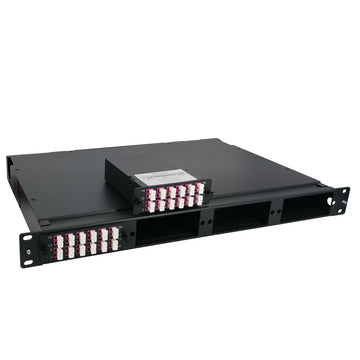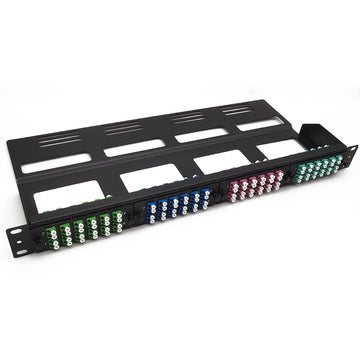Optical Transport Network (OTN) for High Speed Service
What Is OTN Network?
Optical Transport Network (OTN) is a protocol for sending network messaging over optical fiber networks. Experts define OTN as a collection of optical network elements (ONE) that communicate using wavelength division multiplexing (WDM). Since multiple data frames have been wrapped together into a single entity in OTN, it is also known as the “digital wrapper”. OTN is a next-generation, industry-standard protocol that provides an efficient and globally accepted way to multiplex different services onto optical light paths.
In future networking, high speed transmission is no doubt the migration trend. Inspired by the SONET/SDH network, ITU-T (ITU Telecommunication Standardization Sector) has defined the optical transport network (OTN) to achieve a more cost-effective high speed network with the help of WDM technology. However, unlike the previous SONET/SDH, OTN is a fully transparent network that provides support for optical networking on a WDM basis. OTN integrates functions of transporting, multiplexing, routing, management, supervision, and builds OTN client (e.g. SONET/SDH, IP, ATM) connections in the Metro and Core networks. Nowadays, it is widely deployed in the metro, regional and long-haul DWDM packet-optical transport networks.

Working Principle of OTN
OPU, ODU and OTU are the three overhead areas of OTN frame. Actually, its working structure and format very resemble the SONET/SDH network. Six layers are included in the OTN network: OPU (optical payload unit), ODU (optical data unit), OTU (optical transport unit), OCh (optical channel), OMS (optical multiplex section) and OTS (optical transport section).
- OPU:Similar to the “path” layer of SONET/SDH, which provides information on the type of signal mapped into the payload and the mapping structure.
- ODU: Resembles the “line overhead” layer of SONET/SDH, which adds the optical path-level monitoring, alarm indication signals, automatic protection switching bytes and embedded data communications channels.
- OTU:Like the “section overhead” in SONET/SDH, and it represents a physical optical port that adds performance monitoring and FEC (forward error correction).
- OCH: For the conversion of electrical signal to optical signal and modulates the DWDM wavelength carrier.
- OMS: Multiplexes several wavelengths in the section between OADMs (optical add drop multiplexer).
- OTS: Multiplexes several wavelengths in the section between OADMs (optical add drop multiplexer).
Key Benefits of OTN Network
OTN network combines the advantages of optical transmission and electrical processing to provide end-to-end, transparent pipe connections, increased spectral efficiency, and large-capacity transmission capabilities for long-haul transmissions. There are eight areas where OTN has a distinct advantage over previous technologies:
- Reduced Cost: With multiple clients transported on a single wavelength and their specific requirements preserved, OTN network reduces the overall cost of transport and ensures efficient bandwidth utilization.
- Efficient Use of Optical Spectrum: OTN facilitates efficient use of DWDM capacity by ensuring consistent fill rates across a network using OTN switches at fiber junctions.
- Determinism: OTN dedicates specific and configurable bandwidth to each service, group of services, or network partition, guaranteeing network capacity and managed performance for each client and no contention between concurrent services or users.
- Virtualized Network Operations: New virtualization techniques such as Optical Virtual Private Networks (O-VPNs) provide a dedicated set of network resources to a client, independent of the rest of the network.
- Transport Flexibility: OTN networks enable operators to employ the technologies they need now while enabling the adoption of new technologies as business requirements dictate.
- Secure by Design: OTN networks ensure a high level of privacy and security through hard partitioning of traffic onto dedicated circuits.
- Robust Yet Simple Operations: OTN network management data is carried on a separate channel, completely isolated from user application data, so settings are much more difficult to access and modify through a client interface port.
- Timing Transparency: Timing transparency is important for offering wholesale services for third-party providers. The transparency of OTN enables the networks to carry any service, including Ethernet, storage, digital video, as well as SONET/SDH without interfering with the client timing.
Migration to High Speed OTN
With the fast evolution of networking, OTN standard is able to reach a higher speed service. Its multiplexing hierarchy allows any OTN switch and any WDM platform to electronically groom and switch lower-rate services within 10 Gbps, 40 Gbps, or even 100 Gbps wavelengths. This eliminates the need for external wavelength demultiplexing and manual interconnects. OTN network is definitely the best solution for future high speed networking over long distance. The picture below shows the OTN mapping diagram for high speed transmission.

Optical Transport Network Solutions
Network traffic used to be all about voice calls carried over circuit-based networks in a predictable network connection between pairs of endpoints. Today, most network traffic is packet-based, generated by a multitude of services and applications in bursty, unpredictable traffic patterns, with widely varying and more stringent demands on bandwidth and data transmission performance.
WDM MUX/DEMUX, Optical Add/Drop multiplexer (OADM), EDFA, WDM transponder/muxponder, optical line protection (OLP) card, variable optical attenuator (VOA), etc. are the products used in OTN networks. For different network requirements of every individual network task, the equipment deployed in an OTN network can be various. Following list some common OTN-based products as well as their functions.
| Item | Function |
| WDM MUX/DEMUX | Provide high-performance signal division and multiplex |
| OADM | Add/drop the selected wavelengths in one or multiple channels |
| EDFA | Extend the power budget over long distances |
| WDM Transponder/Muxponder |
Provide functions as electrical and optical signals conversions, and wavelength conversion/additional functionality of multiplexing |
| OLP | Optical line protection for optical power monitoring and automatic switching |
| VOA | Variable optical attenuator for optical power management |
Conclusion
All in all, OTN technology represents both a technical leap forward in optical networking over SONET/SDH and a business opportunity for carriers and service providers alike. OTN networks can fully leverage the transport infrastructure in the era of data/transport convergence by offering carriers unprecedented architectural flexibility, client-protocol independence, and service differentiation. OTN network has come of age and will certainly continue to evolve as traffic demand grows. I believe more and more people will employ this standard in their own network in the near future.
If you have any further questions about optical transport network (OTN), you can always get in touch with www.lightoptics.co.uk staff via sales@lightoptics.co.uk.












